|
Compromise of 1850
Slavery Comprise History
Expansion of Slavery History
| Compromise of 1850 Map & Expansion of Slavery |
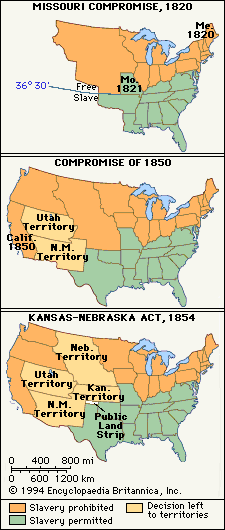
|
| Slave Compromise of 1850 and Civil War |
| Compromise of 1850 Map and Slavery Expansion |
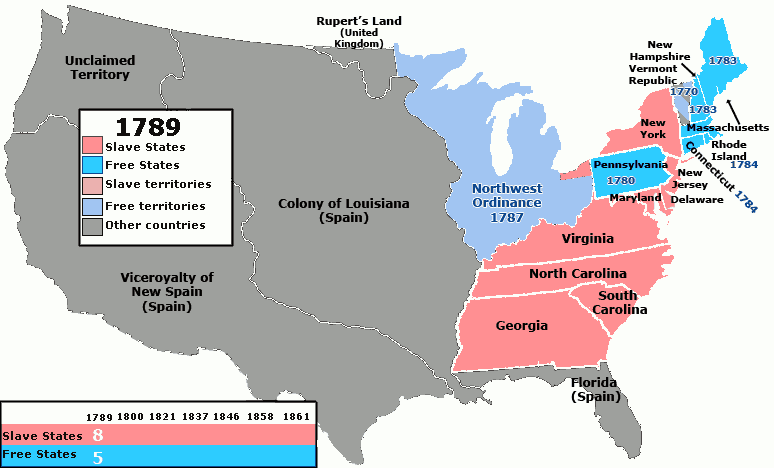
|
| Compromise of 1850 dealt with the expansion of slavery into acquired territory by the United States |
| Acquired lands caused the Compromise of 1850 Map |
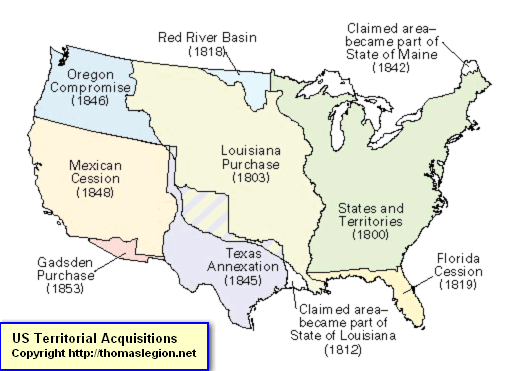
|
| Map of Compromise of 1850 |
Introduction
The Compromise of 1850, like any compromise, was a compromise intended to satisfy
the parties involved by making slavery concessions acceptable to all concerned. The major difficulty in maintaining any
compromise is the test of time, because due to unforeseen circumstances and situations that arise the agreement usually
needs to be amended or perhaps discarded. Regarding a long list of compromises and the subject of slavery and its expansion
into new territories and states acquired by the United States, the Compromise of 1850 followed the Missouri Compromise of 1820, which was ruled unconstitutional and later repealed by the Kansas Nebraska Act of 1854.
Why so many compromises? Simple answer. Although the 13 Colonies had
declared their independence in 1776 and formed the United States of America, the new nation grew rapidly by expanding
its boundaries through a series of land acquisitions. With each transaction, the question arose as to whether or not the new
soil would become a slave or free state. In merely four years, 1845-1848, the United States had concluded its largest
procurement of territory in its history, pushing its western boundary to the Pacific Ocean. With the annexation and statehood
of Texas in 1845 and the nation's acquisition of 55% of the territory of Mexico during the Mexican Cession
of 1848, the U.S. had increased its borders by more than 60% and now extended from coast to coast and sea to shining sea.
The Compromise of 1850 was born out of the largest land purchase in the
nation's history in 1848, and after 1850 the balance between slave and free states no longer existed. Until 1850 the nation
had hosted 15 free and 15 slave states, creating an equitable balance in political power. But with the Mexican Cession in 1848, officially the Treaty of Guadalupe Hidalgo, the nation purchased territory that forms the present-day US states of California, Nevada, Utah, most
of Arizona, about half of New Mexico, about a quarter of Colorado, and a small section of Wyoming. Although California
was admitted to the Union as a free state in 1850, the United States soon added three additional free states with Minnesota
in 1858, Oregon in 1859, and Kansas in 1861. The nation was now confronted with an imbalance of political and
economical power between slave and free states, known as sectionalism, which served only to fuel existing tensions between the North and
South. The Mexican Cession resulted in the Compromise of 1850 and the rapid shift in political power and influence,
and it fanned the flames of sectionalism and secession. Eleven years later, in 1861, the very heart and soul of the Union itself would be challenged during the nation's
Civil War.
What was the Compromise of
1850?
The 1850 Compromise was the genesis of five bills passed mainly to
address issues related to slavery. The bills provided for slavery to be decided by popular sovereignty in the admission of new states, prohibited the slave trade in the District of Columbia, settled a Texas border dispute, and established a stricter fugitive slave act requiring citizens to assist
in the recovery of runaway slaves. See also Transcript of the Compromise of 1850.
What Caused the Compromise of 1850?
The Compromise of 1850 was caused by the purchase of 55% of Mexico's territory by the United States according to terms agreed upon in
the Mexican Cession of 1848. Lands gained by the Mexican Cession, a result of the U.S. victory in the Mexican-American War (1845-1848), with the recent statehood of Texas in 1845, added more than 60% to the size of the United States in just four years. With the defeat of Mexico and the
newly purchased territory by the nation at the discounted price of $15,000,000, numerous states would be created,
forcing the institution of slavery to the forefront of both houses, resulting in some of the most contentious debates in the
nation's history.
| Compromise of 1850 Map and Slavery Issue |
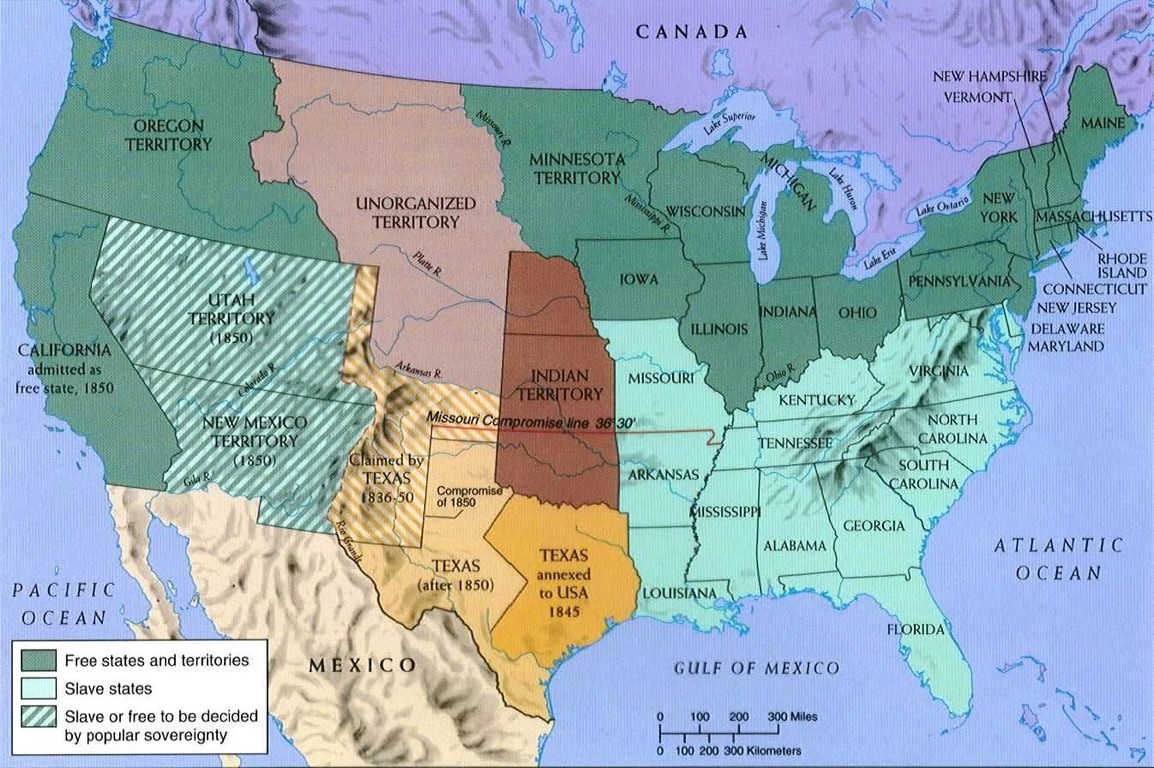
|
| Compromise of 1850 and Fugitive Slave Law. New lands meant whether slavery would be permitted. |
What was the Result of the
Compromise of 1850?
The major result of the Compromise of 1850 was that it failed to create
and preserve the political balance between free and slave states in the Union. The Compromise caused an
imbalance with 15 slave and 19 free states, resulting in political and economical power which favored the North,
causing sectionalism.
Immediately following the vast territory purchased from Mexico in the Mexican
Cession of 1848, Washington debated whether the territory should be carved into slave or free states. Prior to the Cession
there were 15 free and 15 slave states, but subsequent to the Compromise of 1850, California was admitted to the Union as
a free state in 1850, followed by three additional free states with Minnesota in 1858, Oregon in 1859, and Kansas in
1861. No slave states were added to the United States during that time, so the nation was now confronted with
an inequitable balance of political power known as sectionalism, which served only to fuel existing
tensions between the Northern and Southern states. The Mexican Cession resulted in the Compromise of 1850, the rapid shift
in political power and influence, and finally the American Civil War. Because the Compromise produced sectionalism, in
just eleven years, 1861, the nation would be engaged in bloody Civil
War in an effort to contest and settle on the battlefield what it had failed
to achieve in both houses of Congress for nearly one century.
| Slave Compromises in and United States Map |
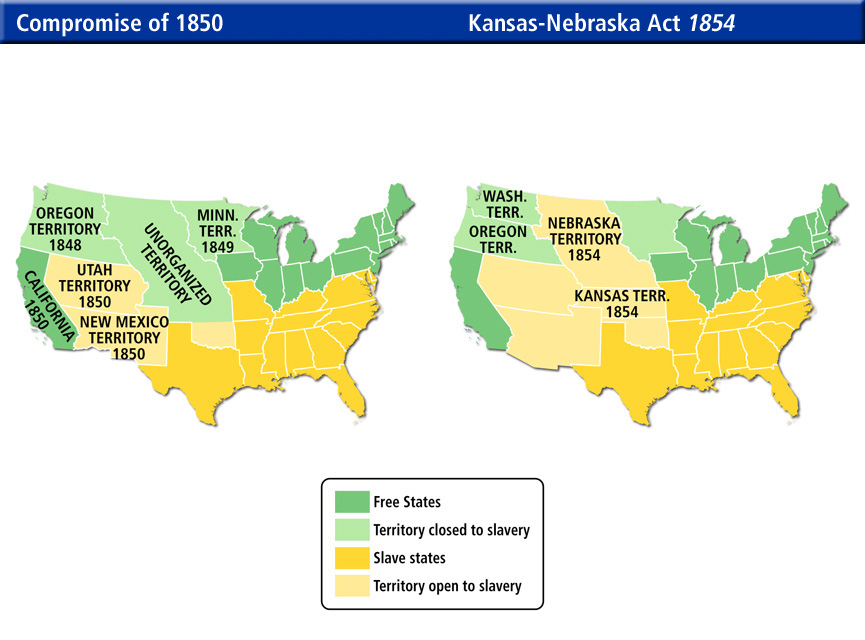
|
| Compromise of 1850 and Kansas-Nebraska Act of 1854 Map |
(About) The Missouri Compromise of 1820 was ruled unconstitutional by the
Supreme Court and superseded by the Kansas-Nebraska Act of 1854, which also succeeded the Compromise of 1850. Because each compromise
strived to maintain a political balance between free and slave states, but did not address whether the nation itself should
be antislavery or proslavery, the opposing sides would soon decide their sectional differences on the battlefield during the
American Civil War, which began in 1861.
| Compromise of 1850 Act and Slavery Laws |
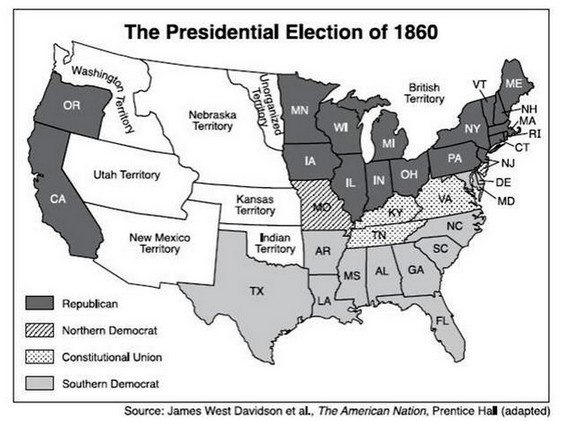
|
| Compromise of 1850 shows a shift in power favoring the North |
History
The Compromise of 1850 consisted of five laws passed in September of
1850 that dealt with the issue of slavery. In 1849, California requested permission to enter the Union as a free state, potentially
upsetting the balance between the free and slave states in the U.S. Senate. Senator Henry Clay introduced a series of resolutions
on January 29, 1850, in an attempt to seek a compromise and avert a crisis between North and South. As part of the Compromise
of 1850, the Fugitive Slave Act, commonly referred to as the Fugitive Slave Law of 1850, was amended and the
slave trade in Washington, D.C., was abolished. Furthermore, California entered the Union as a free state and a territorial
government was created in Utah. Also, an act was passed settling a boundary dispute between Texas and New Mexico that also
established a territorial government in New Mexico.
The Compromise of 1850 Consisted
of the Following Five Bills:
1) California entered the Union as a free state.
2) New Mexico
and Utah were each allowed to use popular sovereignty to decide the issue of slavery. In other words, the people would decide whether
the states would be free or slave.
3) The Republic of Texas relinquished claimed land in present-day New Mexico and received $10
million to pay its debt to Mexico.
4) The slave trade was abolished in the District of Columbia.
5) The Fugitive Slave Act made any federal official who did not arrest a runaway slave liable to
pay a fine. See also Compromise of 1850 and the Fugitive Slave Law.
Analysis
The Compromise of 1850 dealt with the expansion of slavery into recently
acquired territory by the United States.
The Compromise of 1850 was a direct result of the lands obtained by
the United States in the Mexican Cession, officially Treaty of Guadalupe Hidalgo in 1848. Because of its humiliating defeat during the Mexican War (1846-1848), Mexico
gave the US a majority stake, a mammoth 55% of its territory. With the vast territory acquired rapidly by the US,
the expansion of slavery was hurled onto the floors at both houses of Washington in some very heated debates, including
the Compromise of 1850.
Once the Treaty was signed, the United States owned more than one-half
of Mexico and it now spanned from the Atlantic to Pacific oceans. From the signing of the Declaration of Independence on July
4, 1776, the fledgling 13 Colonies had expanded westward and from sea to shining sea in merely 72 years, and by doing so it
had henceforth removed the presence of the world powers of England, Spain, and France.
| History Map of Compromise of 1850 |
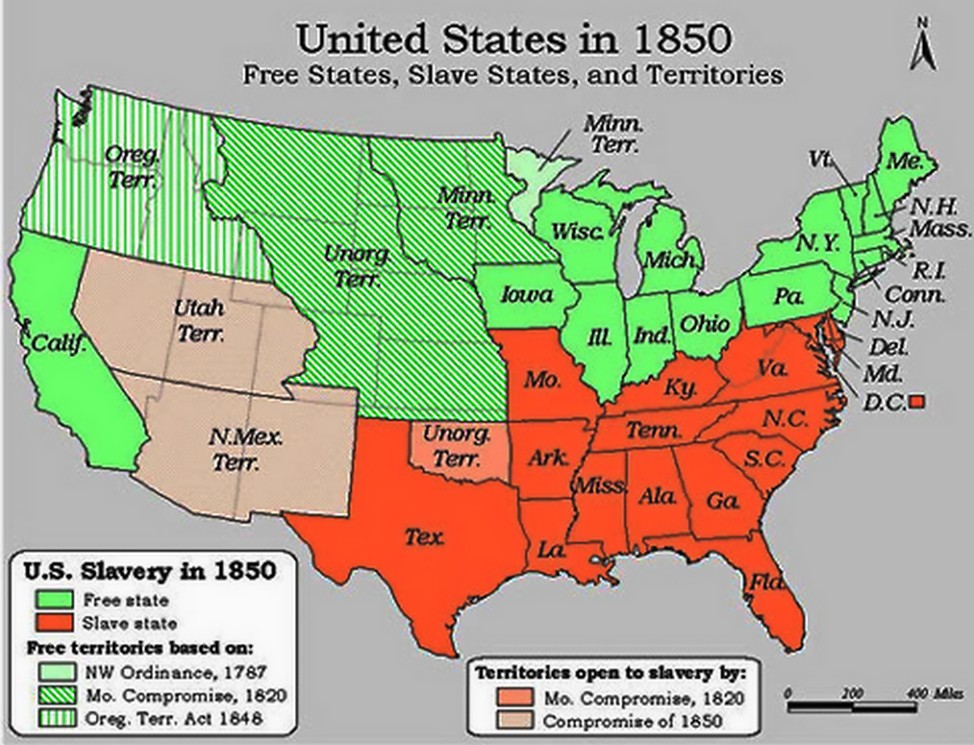
|
| Slave and Free States Map. Compromise of 1850 and Slavery Map. |
The cost of the Mexican Cession was
immense for both nations, however. Following the humiliating defeat Mexico plunged into civil war and with its loss of vast
territory to its north, its economy and infrastructure would be stymied for nearly a century. Just
weeks after the Mexican Cession was signed, gold was discovered in California (California was known for a long time as El
Dorado, which means “the land of gold” in Spanish), leading to the largest gold rush in the history of the United
States. But unfortunately for Mexico, El Dorado was not part of Mexico anymore. Americans known as 49ers
would enjoy one of the greatest spoils of war in world history. (Now you know the origin of the namesake San Francisco
49ers.)
The United States and its major
territorial acquisition made slavery and its expansion the center of numerous contentious debates in both houses.
General Zachary Taylor had won fame in the Mexican War and would ride his battlefield successes into the White House.
As the 12th US President, Taylor had succeeded his commander-in-chief, President James K. Polk, who had pressed
the nation into the Mexican War. President Polk, who had promised the nation that he would be a one term President, died of
cholera just three months after leaving office. Taylor, a Southerner but Unionist at heart, was now confronted with the results of his acclaimed
generalship during the recent conflict, but while in office he strived to appease both the North and South on the
issue of slavery through a series of compromises, such as the Compromise of 1850. After Taylor died from illness just 500
days into office, future US Presidents would continue to pass the mantle of compromises until President Abraham
Lincoln assumed office in 1861 and issued a clarion sound on the subject of slavery, leaving no doubt as to his
position on the peculiar institution. A major result of the Mexican-American War (1846-1848) was an acceleration
of the American Civil War, a conflict between the Northern and Southern states, which commenced in 1861, merely
13 years after the Mexican Cession and at a cost of 620,000 American lives.
(Sources and related reading below.)
Recommended
Reading: Henry Clay: Statesman for the Union. From Library Journal: Award-winning historian Remini has written the definitive biography
on controversial 19th-century politician Henry Clay of Kentucky.
Remini's work, which uses a rich array of primary sources, especially letters uncovered by the Henry Clay Papers publication
project, surpasses earlier studies of Clay by Glyndon Van Deusen (The Life of Henry Clay, Greenwood, 1979) and Clement Eaton
(Henry Clay & the Art of American Politics, 1962). All facets of Clay's life are examined, especially much new information
about his private life and how it influenced his public political career. Remini analyzes why an accomplished political leader
such as Clay could never be elected president, though he ran for the office five times. Continued below….
Clay's political
success came from his extraordinary talents as the engineer who directed three major compromises between 1820 and 1850 through
Congress, thus averting civil strife and keeping the Union together. This is an
excellently written, superbly crafted, and long-needed biography that is suitable for academic and large public libraries.
Recommended Reading:
The Impending Crisis, 1848-1861
(Paperback), by David M. Potter. Review: Professor Potter treats an incredibly complicated and misinterpreted time period with unparalleled
objectivity and insight. Potter masterfully explains the climatic events that led to Southern secession – a greatly
divided nation – and the Civil War: the social, political and ideological conflicts; culture; American expansionism,
sectionalism and popular sovereignty; economic and tariff systems; and slavery. In other words, Potter places under the microscope the root causes and origins
of the Civil War. He conveys the subjects in easy to understand language to edify the reader's
understanding (it's not like reading some dry old history book). Delving
beyond surface meanings and interpretations, this book analyzes not only the history, but the historiography of the time period
as well. Continued below…
Professor Potter
rejects the historian's tendency to review the period with all the benefits of hindsight. He simply traces the events, allowing
the reader a step-by-step walk through time, the various views, and contemplates the interpretations of contemporaries and
other historians. Potter then moves forward with his analysis. The Impending Crisis is the absolute gold-standard of historical
writing… This simply is the book by which, not only other antebellum era books, but all history books should be judged.
Recommended Reading: What Hath God Wrought: The Transformation of America, 1815-1848 (Oxford History of the United States) (Hardcover: 928 pages). Review: The newest volume in the renowned Oxford History
of the United States-- A brilliant portrait of an era that saw dramatic transformations in American life The Oxford History
of the United States is by far the most
respected multi-volume history of our nation. The series includes two Pulitzer Prize winners, two New York Times bestsellers,
and winners of the Bancroft and Parkman Prizes. Now, in What Hath God Wrought, historian Daniel Walker Howe illuminates
the period from the battle of New Orleans to the end of the Mexican-American War, an era when
the United States expanded to the Pacific
and won control over the richest part of the North American continent. Continued below…
Howe's panoramic
narrative portrays revolutionary improvements in transportation and communications that accelerated the extension of the American
empire. Railroads, canals, newspapers, and the telegraph dramatically lowered travel times and spurred the spread of information.
These innovations prompted the emergence of mass political parties and stimulated America's economic development from
an overwhelmingly rural country to a diversified economy in which commerce and industry took their place alongside agriculture.
In his story, the author weaves together political and military events with social, economic, and cultural history. He examines
the rise of Andrew Jackson and his Democratic party, but contends that John Quincy Adams and other Whigs--advocates of public
education and economic integration, defenders of the rights of Indians, women, and African-Americans--were the true prophets
of America's future. He reveals the power
of religion to shape many aspects of American life during this period, including slavery and antislavery, women's rights and
other reform movements, politics, education, and literature. Howe's story of American expansion -- Manifest Destiny -- culminates
in the bitterly controversial but brilliantly executed war waged against Mexico
to gain California and Texas for the United States. By 1848, America
had been transformed. What Hath God Wrought provides a monumental narrative of this
formative period in United States history.
Recommended Reading: Abraham
Lincoln: Redeemer President (Library of Religious Biography). Description: Since its original publication in 1999, "Abraham Lincoln: Redeemer President" has
garnered numerous accolades, including the prestigious 2000 Lincoln Prize. Allen Guelzo's peerless biography of America's most celebrated president is now available for the
first time in a fine paperback edition. Continued below...
The first "intellectual biography" of Lincoln, this work explores the role of ideas
in Lincoln's life, treating him as a serious thinker deeply
involved in the nineteenth-century debates over politics, religion, and culture. Written with passion and dramatic impact,
Guelzo's masterful study offers a revealing new perspective on a man whose life was in many ways a paradox. As journalist
Richard N. Ostling notes, "Much has been written about Lincoln's
belief and disbelief," but Guelzo's extraordinary account "goes deeper."
Recommended Reading: Lincoln
and Douglas: The Debates that Defined America
(Simon & Schuster) (February 5, 2008) (Hardcover). Description: In 1858, Abraham Lincoln was known as a successful Illinois
lawyer who had achieved some prominence in state politics as a leader in the new Republican Party. Two years later, he was
elected president and was on his way to becoming the greatest chief executive in American history. What carried this one-term
congressman from obscurity to fame was the campaign he mounted for the United States Senate against the country's most formidable
politician, Stephen A. Douglas, in the summer and fall of 1858. Lincoln challenged Douglas
directly in one of his greatest speeches -- "A house divided against itself cannot stand" -- and confronted Douglas on the
questions of slavery and the inviolability of the Union in seven fierce debates. As this
brilliant narrative by the prize-winning Lincoln scholar Allen Guelzo dramatizes, Lincoln would emerge a predominant national figure, the leader of his
party, the man who would bear the burden of the national confrontation. Continued below...
Of course,
the great issue between Lincoln and Douglas was slavery. Douglas was the champion of "popular sovereignty," of letting states and territories decide
for themselves whether to legalize slavery. Lincoln drew a
moral line, arguing that slavery was a violation both of natural law and of the principles expressed in the Declaration of
Independence. No majority could ever make slavery right, he argued. Lincoln lost that Senate
race to Douglas, though he came close to toppling the "Little Giant," whom almost everyone
thought was unbeatable. Guelzo's Lincoln and Douglas brings alive their debates and this whole year of campaigns and underscores
their centrality in the greatest conflict in American history. The encounters between Lincoln and Douglas engage a key question
in American political life: What is democracy's purpose? Is it to satisfy the desires of the majority? Or is it to achieve
a just and moral public order? These were the real questions in 1858 that led to the Civil War. They remain questions for
Americans today.
Recommended Reading:
American Slavery, American Freedom.
Description: "If it is possible to understand the American
paradox, the marriage of slavery and freedom, Virginia is surely the place to begin," writes
Edmund S. Morgan in American Slavery, American Freedom, a study of the tragic contradiction at the core of America. Morgan finds the key to this central paradox in the people and politics
of the state that was both the birthplace of the revolution and the largest slaveholding state in the country. With a new
introduction. Winner of the Francis Parkman Prize and the Albert J. Beveridge Award. Continued below...
About the Author:
Edmund S. Morgan is Sterling Professor of History Emeritus at Yale University
and the author of Benjamin Franklin. Morgan was awarded the National Humanities Medal in 2000.
Recommended Reading: Arguing about Slavery: John Quincy Adams and the Great Battle
in the United States Congress.
Description: In the 1830s, slavery was so deeply entrenched
that it could not even be discussed in Congress, which had enacted a "gag rule" to ensure that anti-slavery petitions would
be summarily rejected. This stirring book chronicles the parliamentary battle to bring "the peculiar institution" into the
national debate, a battle that some historians have called "the Pearl Harbor of the slavery
controversy." The campaign to make slavery officially and respectably debatable was waged by John Quincy Adams who spent nine
years defying gags, accusations of treason, and assassination threats. In the end he made his case through a combination of
cunning and sheer endurance. Telling this story with a brilliant command of detail, Arguing About Slavery endows history with
majestic sweep, heroism, and moral weight.
Sources: U.S. Department of State; Stanley W. Campbell, The Slave Catchers:
Enforcement of the Fugitive Slave Law, 1850-1860, 1970; Don E. Fehrenbacher, The Slaveholding Republic : An Account of the
United States Government's Relations to Slavery, 2002; John Hope Franklin and Loren Schweninger, Runaway Slaves: Rebels on
the Plantation, 1999 Yale Law School: The Avalon Project; Library of Congress, National Archives, National Park Service, Ourdocuments.gov,
US Department of State, WhiteHouse.gov, US Census Bureau, nationaatlas.gov.
|

